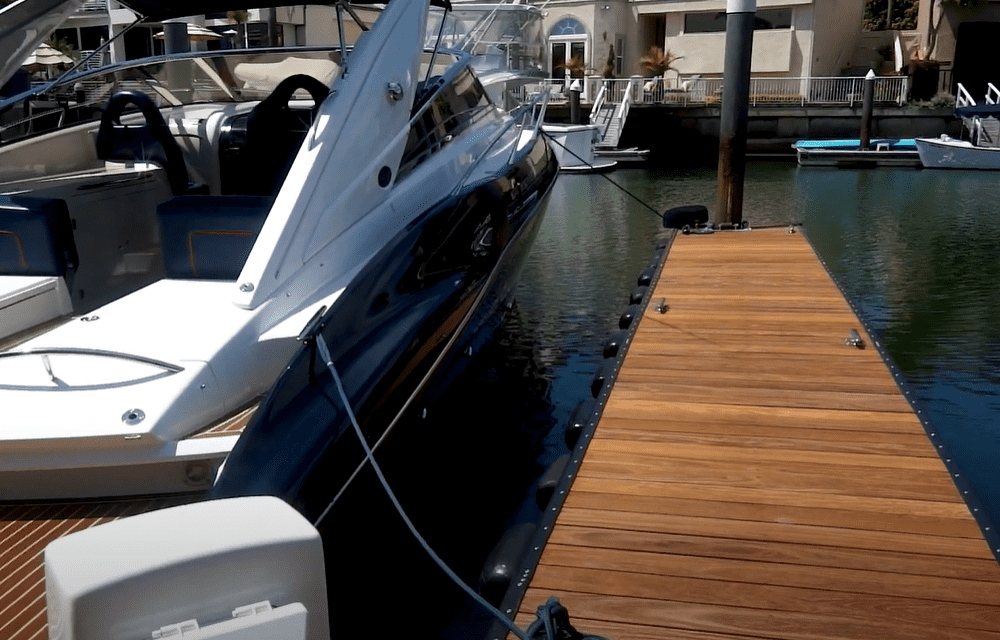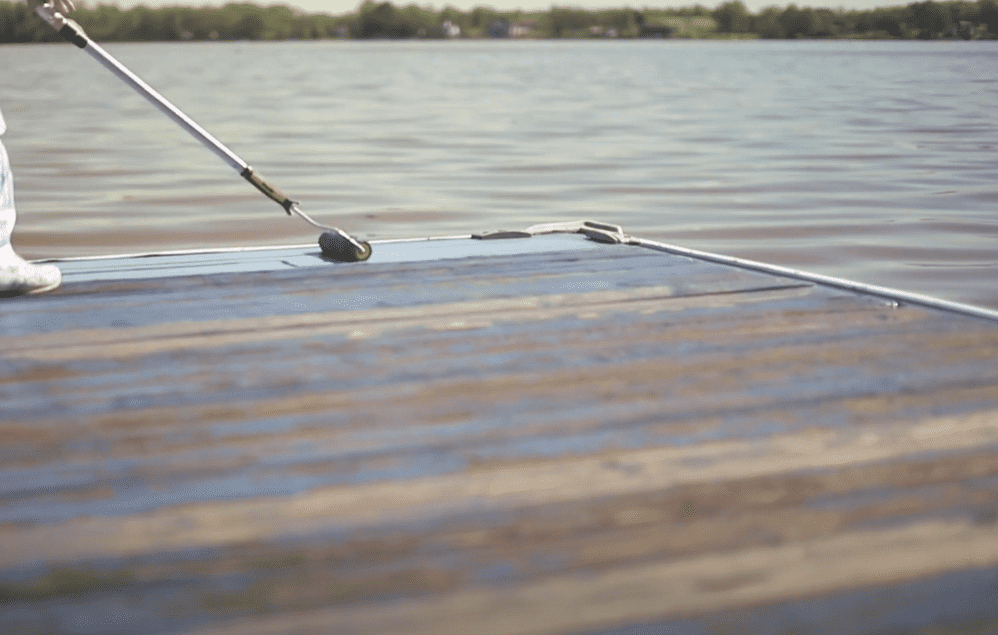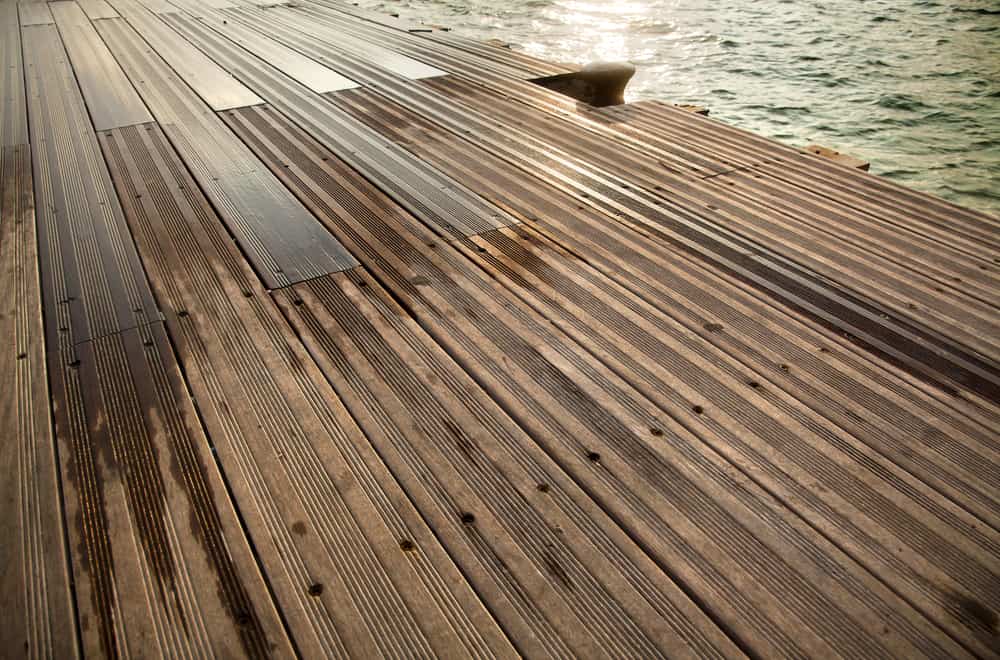Painting your boat dock helps to keep it protected from weather and other elements. And with the right product, you will prevent yourself and others from falling under slippery conditions.
To ensure quality results, I have prepared a guide that details each step of the process for you. In addition, this article will help you decide between products and provide you with a list of tools and equipment you will need to take on your dock painting project.
Table of Contents
What You Will Need for dock painting
When you get ready to paint your boat dock, you will carefully select the most suitable product for your dock material. Other tools and equipment you should have or have access to include:
- booties
- rolling pan
- wide, narrow, and angle-cut paintbrushes
- paint roller with extension handle
- heavy-duty outside broom
- pressure washer
- water hose with fresh water hookup
- safety glasses
- gloves
- safety mask
A Little Bit About Boat Docks
Traditionally, wood is the material of choice for boat docks. However, as with any product made of wood (even your boat, perhaps), regular maintenance is required if you expect it to last.
Treated pine is often the go-to choice because of its resistance and affordability. However, it will be best to re-seal this wood every year or two to prevent rot and other moisture issues.
Western red cedar is another top choice due to its superior resistance against wood rot and pests. Other great wood choices include redwood, cypress, fir, and other hardwoods.
There is no better time than now to take a stroll over to your boat dock and inspect it for any damage. In addition, you should plan to repaint your wooden boat dock once every two years to extend its life.
The Advantages Of Painting Your Boat Dock
Water can cause weakness, cracking, rot, and mold to wooden items, including your boat dock. Painting your boat dock and performing regular maintenance is a great way to keep your dock looking pretty.
In addition, dock painting provides several practical advantages that will extend its life, including:
- makes your dock look nice
- protects the dock from constant sun exposure
- adds a waterproof layer to the wood
- creates a more durable surface
- helps prevent the wood from splintering or chipping
- protects hardware from rusting
- softens the effects from vibration
- protects against corrosion
- creates anti-slip surface
How to Paint Boat Docks?
You can break down any paint process into three main stages: preparation, priming, and painting. However, the most critical step of any painting project will be the preparation stage.
Step 1. Prep Stage
Before anything, closely inspect your entire dock and associated hardware for damage, weakness, safety issues, or unsightly paint chipping. Early in the preparation stage is the best time to repair these specific areas before moving on.
With repairs complete, it’s time to move on. At this point, I suggest that you grab a heavy-duty broom to sweep off dirt and debris from your boat dock. I’d even recommend considering pressure washing its surface before proceeding for neglected or filthy surfaces.
You might be wondering why you need to clean the surface if you sand it down anyway. It makes the process more hygienic and prevents debris and dirt from lodging inside the wood grain.
Once cleaned, you can now gather everything needed for sanding. Especially if your dock has been previously sealed or painted, the next step is to sand the entire surface to ensure that the new paint properly adheres.
It would be best to wear suitable protective gear such as a particulate mask, eye protection, and gloves for sanding. Since you will be spending a lot of time on all-fours sanding your boat dock, I would also suggest investing in a good pair of knee pads.
You may choose to either sand your dock by hand or utilize a power sander to speed up the process. Whatever method you find best, you should employ a gentle and consistent circular sanding motion and remember that too smooth a surface will resist the stain or paint you intend to use.
So, begin the sanding stage with a course paper such as 20-30 grit. Do not use anything finer than 80-grit for the finished surface. If you do, you risk crushing the wood grain to the point that it becomes too smooth to accept new paint.
Once you have finished sanding, grab your broom again and sweep the area from dust. Next, grab a hose and gently wash your boat dock’s surface clean.
Although the preparation stage is pretty straightforward, there is a lot of information to remember. Here is a quick reference guide on the steps to follow when preparing your boat dock for paint:
- Inspect and repair damaged areas
- Sweep or pressure wash
- Sand
- Sweep or wash again
- Ensure adequate drying time
Step 2. Priming Stage
I advise looking ahead to your local weather forecast and choosing a project start date where you have at least two to three days of favorable weather for complete drying.
With the hard work behind you, it’s now time to begin priming your boat dock. But, before you start, gather all the necessary materials for the job:
- booties
- primer
- paintbrush
- smooth (short nap) paint roller
- extension handle
DuraBak EP90 is a durable epoxy primer that even the U.S. Navy trusts for its superior performance. It has been designed for universal application and specifically purposed with safety in mind.
Step 3. Painting Stage
Once the primer has completely dried, you can paint your boat dock. Similarly, pour the paint contents into a roller pan and be sure to cover the entire boat dock adequately.
Once the initial coat is dry to the touch, you can apply your second layer of paint. If you like what DuraBak has to offer, then why not stick with their acclaimed DuraBak 18 Marine Liner (Textured) with sixteen color varieties.
Depending on temperature and climate, it may take a full day for drying and up to three days for curing. It will help if you post a sign or rope off the area to prevent anyone from using the dock before it has completely cured.
Dock Maintenance
Now that your boat dock has a fresh coat of paint, you should plan for regular cleaning and maintenance so that it will last for years to come. It would be best to give your deck a good cleaning at least once a month.
Each time you walk your boat dock, make it a habit to look around for any damage or areas needing attention. Then, resolve any issues as soon as possible to prevent further damage, such as water penetration and rot.
Docks are often susceptible to damage from the wear and tear caused by boats pulling up to their sides. Common practice is to cover all corners with carpet or rubber mats. In addition, you can place rubber bumpers on the sides to prevent banging from boats.
The wear and tear of your boat dock relate to how often you use it and how much foot traffic it supports. However, just because you don’t get out much on the water for a particular season does not mean you can neglect dock maintenance.
The routine inspection, cleaning, and painting of your boat dock significantly improves its safety and extends its lifespan.
Dock Safety
Painting your dock is one way to ensure the safety of you, fellow boaters, and passengers. It can reduce the risk of slips and falls and works to seal over an otherwise potentially uncomfortable foot surface.
Consider the different uses for your dock and keep it clean from trash, fishing hooks, and other potentially dangerous items. I would even mount a covered trash bin at either side of the dock to prevent any litter from falling into the water, harming fish and other wildlife.
What About Dock Pilings And Caps
Docks often sit somewhere between twelve to twenty inches above the surface of the water, depending on your particular preference. Although the entire dock sees its share of harsh weather and various elements, the bottom is constantly sloshed and splashed with water.
But what about dock pilings and caps? You might be thinking about how you can provide additional protection to these specific parts of your boat dock.
Often, people will seal the wooden pilings with tar- a practical option that is much more affordable.
If you have the means, choose to protect your wooden pilings with sleeves or wraps. A lumberyard or specific manufacturer will outfit the pilings with one of these options before installation.
Instead, use plastic or copper caps for the tops of your dock pilings to prevent nesting, deterioration, and other damage caused by sun and water exposure.
Conclusion
Painting your boat dock is just as important as maintaining your boat’s exterior. By following the procedures outlined in this article, you will extend the life of your boat dock by protecting it from weather and other elements.
If you have any questions or concerns regarding various products or specific painting procedures, please leave them in the comment section below.

Joseph Fabiano is a writer, nature enthusiast, and stay-at-home father of two wild and free boys. He enjoys starting his day with a good run, hot mug of coffee, and a jump in the Ionian Sea, no matter the weather. Currently based in the Apuglia region of southern Italy, he enjoys discovering the world with his best traveling buddies (his little monkey’s and beautiful wife) at every given opportunity. Every trip, long or far, should be made an adventure according to Joseph as he believes inspiration and creation is right in front of you.






